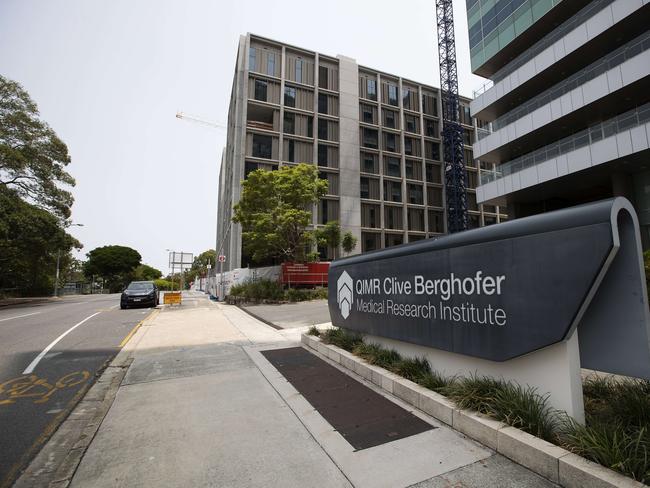Depression and the FKBP5 gene: how trauma can change how genes behave
Michael Clancy had never experienced mental illness in his life until he witnessed the 2016 Dreamworld disaster up close. A DNA test might have revealed how badly it would affect him.

In a laboratory nestled in the sprawling leafy campus of the University of Wollongong, south of Sydney, Natalie Matosin is examining tissue samples from more than 1000 post-mortem human brains. She’s a neurobiologist, but you might call her a genetic detective. Her investigative gaze is focused on a particular protein coding gene that looks set to be the target of the world’s first personalised medicines for depression and schizophrenia.
“There are scientists who are more the drug hunters, whereas I’m like the target finder,” Matosin says. “I’m looking at these human brain specimens from people with psychiatric disorders trying to find what’s different about these brains, because this is ultimately providing the basis for drug development.”

The protein coding gene that is of interest to Matosin is called FKBP5, which is key to how humans deal with stress. Her study, conducted with an international team that recently published its findings, confirmed what science has now firmly established: that people with mental illness have elevated levels of the protein that FKBP5 expresses. But Matosin and her colleagues took the science one step further: they were able to identify the specific cell type in which FKBP5 is most affected in individuals.
“There have been more than 30 individual studies now of this gene across 39 different patient cohorts looking at over 30,000 people from research groups and laboratories across the whole world,” Matosin says.
“What those studies have basically found is that FKBP5 on its own doesn’t raise risk of psychiatric disorders but if you carry a version of the gene that raises your risk and you’re exposed to childhood adversity, then you have a higher risk of developing a psychiatric disorder, and that happens via epigenetic mechanisms.”
Epigenetics is akin to an extra layer of function that is superimposed upon your genes. Put simply, your lifestyle and experiences change the expression of your genes. If you experience a major trauma, for instance, certain molecular components derived from enzymes within your cells will be added as biological “tags” on top of your DNA, altering the way genes behave.
“Your DNA can’t change but the epigenetic layer over your DNA is modified by the environment,” Matosin says. “Pretty much everything we experience in life is impacting on our DNA through epigenetic mechanisms.”
The upshot of all of this is that identifying risk factors for many diseases is a devilishly complex task. When the human genome was first fully mapped two decades ago, few foresaw how immense the task ahead would be in identifying gene variants associated with certain diseases.
While in a small number of diseases such as haemophilia and cystic fibrosis a single gene is responsible for an individual’s risk, in population-wide conditions such as heart disease, auto-immune diseases and mental illness many hundreds of genes are involved in elevating a person’s risk.
Not only that, DNA variants sometimes don’t control the gene itself but, rather, the “regulatory switch” that controls the expression of the gene. It’s no wonder the field of science working to link genes to disease risk has become known as “complex trait genetics”. Not only must the gene variants be identified but because many of the risk factors for complex diseases are controlled by epigenetics – the gene’s “regulatory switches” – scientists must perform painstaking investigations known as “fine mapping” of trait-associated regions of genomes to identify causal variants.
“Psychiatric traits are complex disorders. So they have a combination of genetic and environmental risk factors,” says Murray Cairns, a professor in the school of biomedical sciences and pharmacy at the University of Newcastle.
“In the case of complex traits, effects come through hundreds if not thousands of gene variants, and rather than knocking out a gene, they tend to modify the expression of the gene. And the effects are cumulative, so you may have different genes that function in different pathways, and when you reach a certain critical mass of changes related to the particular disease, then your risk of that disorder goes up.”
Matosin concurs. “The reality is that most of us are walking around with genes that raise our risk of psychiatric disorders, but for some reason some of us will go on to develop psychiatric disorders while others don’t.”

The plight of Gold Coast man Michael Clancy is a powerful example of the way environmental effects such as major trauma can change the regulatory switches that control genes.
Clancy had never experienced mental illness in his life and has no idea of his genetic profile, but when he witnessed close-up the Dreamworld disaster in 2016, in which four people were killed when their raft flipped on the Thunder River Rapids ride and they were caught in the ride’s conveyor mechanism, he was plunged into a world of trauma.
Clancy was a guest service supervisor and duty manager at Dreamworld at the time and was first on the scene. In the days and months after the accident he was subject to a constant barrage of toxic abuse from the public.
“I felt like a battering ram,” Clancy says. “I couldn’t get out of bed. It felt like everything I did was pointless. It was the darkest place I had been and I never thought it was possible that I would get there.”
He undertook extensive psychotherapy and art therapy and eventually created a charity, Parrots for Purpose, in which people with depression are given parrots as pets, forming therapeutic bonds that have proved a godsend for scores of people. “You can tell the bird anything and you know it’s trusted,” Clancy says. “They’re next to you all the time.”
Like many people suffering severe depression, Clancy had extreme difficulty finding a medication that worked. “They tried 29 different medications. I was hospitalised because they didn’t work,” he says. “I had severe side effects. It was scary.”
This is the nub of the problem that faces many people with mental illness and it’s the driving reason for the extraordinary worldwide effort being poured in to gene association studies.

Many hundreds of scientists have joined forces in an international consortium in which studies are being co-ordinated across continents. Such a mass collaboration between laboratories, institutes and universities is virtually unheard of in the competitive world of science.
“It’s a wonderful sort of chaotic democracy,” says human geneticist Nick Martin from Brisbane’s QIMR Berghofer Medical Research Institute. “It began in 2009 when it became obvious that no one was going to get the answer by themselves. All the scientists were all getting nowhere because they all assumed there would be these big genes to find. It became apparent over quite a short period of time that was just not the way it was going to be, and the only way that we would get anywhere is by everyone co-operating.
“It’s just been a remarkable success. People have buried their egos and contributed to this worldwide effort. And we’ve really started to get somewhere.”
Martin is leading the Australian Genetics of Depression study, which recruited more than 30,000 people in just one month in 2017. The findings so far from that study have contributed to the identification of about 50 gene variants that have been added to the mix of at least 500 implicated in depression that have been discovered worldwide. Scientists believe they’ve pretty much identified all of the major genes, clusters of variants and regulatory switches involved in depression.
QIMR Berghofer scientists have been able to devise a “polygenic risk score” for individuals that can be quantified from the mapping of their genome. They’ve discovered that those who fall within the highest 10 per cent on this metric have seven times the risk of developing depression than those in the lowest 10 per cent.
The project also established through patient surveys that antidepressants were effective for only one-third of the study’s cohort.
“Moving beyond actually finding the genes for depression is actually finding the genes that determine why one person responds to a particular drug but another doesn’t,” Martin says. “The whole hope here is to try to get over that rather miserable cycle of prescribing failure, which is hugely expensive and extremely stressful for the patient.
“The ideal would be that somebody comes in to the doctor for depression, they take a DNA sample, we carry out genotyping, then we choose the best drug. And that will have a much higher success rate than if we just choose drugs at random, which is pretty much what happens now.”
Pharmacologist Treasure McGuire, the assistant director of pharmacy at Mater Health in Brisbane, says an individual’s genetic makeup controls not only whether they will respond to a particular drug but also how it will be metabolised in their body, affecting the appropriate dosage. This phenomenon is known as pharmacogenetics and is a growing field of study.
“What we’re recognising now and has been encoded into the DSM-5 (Diagnostic and Statistical Manual of Mental Disorders) is there truly are people who are more resistant to antidepressants and there can be genetic reasons for that, but there can also be as part of that gene variation, what we call a pharmacogenomic difference depending on how the drug is metabolised in the liver, says McGuire, who holds joint associate professor posts at Bond University and the University of Queensland. “You could be an ultra-rapid metaboliser, you could be normal or you could be an ultra-slow metaboliser.”
Cairns says the problem with current psychiatric drugs, and the reason they do not work for so many people, is they target symptoms rather than biological cause. Genetics can potentially reveal the underlying mechanism and open up the way for personalised medicines.
“When an individual is at risk of these disorders, they will have many, many different genes that are affected, but in a subtle way,” he says.
“And there are extreme levels of heterogeneity between individuals. So at the population level, we know that these genes are involved.
“But when you look at any given individual, they may not have that risk, they may not have those genes affected. It’s about the pathways that these genes fall into. And usually these variants are clustered together into biological pathways. In my laboratory, we’re trying to use precision medicine where we look at an individual’s constellation of risk variants that relate to drug function so we can find out whether someone is more or less likely to respond to a particular drug.
“It’s about triangulating the disease with an individual and particular drugs.”
The future for precision medicine in mental health and other diseases is enormous, but the worldwide findings on genomic risk factors will need to be individualised in every single person.
“Definitely these gene discoveries suggest new drug targets, but those drug targets will not be relevant in every person,” Cairns says. “So you’ve got to tailor treatment more specifically to an individual’s combination of variants.
“It’s not just about discovering the genes; you’ve got to put them together and look at how they work in a given individual. It’s not simple.”
Patients such as Clancy have no doubt this kind of personalised medicine could change their lives.
“Absolutely 100 per cent,” he says. “So far the parrots have been the only thing that truly worked for me.”






To join the conversation, please log in. Don't have an account? Register
Join the conversation, you are commenting as Logout